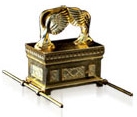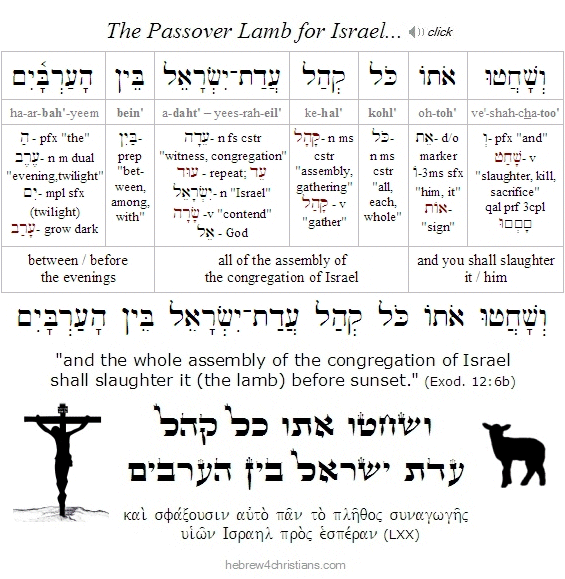|
|
|||||||||||||||||||||
 |
|||||||||||||||||||||
 |
|||||||||||||||||||||
|
|
||||||||||||||||||||||
|
The Book of Leviticus (ספר ויקרא) is to the Torah what the Book of Hebrews is to the New Testament. Leviticus is both the physical and spiritual center of the Five Books of Moses and comprises its ritual expression. The sages count 246 of the 613 commandments of the Torah in this book (over 40%), and many of the Talmud's discussions regarding ritual purity and holiness are based on it.
For Yom Kippur, of course, two goats were required: one goat was for blood sacrifice in the Holy of Holies (the Goat of the LORD) and the other was used as a "scapegoat" for the sins of the community (the goat of Azazel / the devil). The Gospels seem to emphasize the connection between Yeshua as the "Lamb of God who takes away the sins of the world" with Passover/Exodus more than the connection between Yeshua as the "Goat of the LORD" whose blood was sprinkled upon the Mercy Seat with Yom Kippur - though the author of the Book of Hebrews explicitly makes this connection (Heb. 9:11-12; 24-ff).
Yeshua as the "Lamb of God" pictures personal redemption from slavery to Satan and freedom from the wrath of God. This is the greater Passover/Exodus connection. By means of Yeshua's shed blood and broken body, the wrath of God passes over us and we are set free to serve God.... Yeshua as the "Goat of God" pictures both personal cleansing (i.e., "propitiation" or "expiation" for our sins: the Greek word (ἱλαστήριον) is used in the LXX for the kapporet (Mercy Seat) in the Holy of Holies which was sprinkled with the blood of the sacrifice on Yom Kippur) as well as national teshuvah and cleansing for ethnic Israel at the end of the Great Tribulation period. At that time Yeshua will function as Israel's true High Priest whose sacrifice is applied for Israel's Atonement. This is the Yom Kippur connection. Since the destruction of the Second Temple in AD 70, Judaism has struggled to make sense of the Book of Leviticus' significance. After all, the Rabbis of the Mishnah and Talmud redefined Jewish worship to bypass the Torah's commandments for blood atonement rituals by substituting Torah study, daily prayer, and acts of loving kindness. Thus the Pirke Avot says, "The world stands on three things: Torah, service, and acts of loving kindness (1:2)," and Yochanan ben Zakkai (a primary contributor to the Mishnah who established Judaism without the Temple) appealed to Hosea 6:6 to substitute prayer for sacrifice. Later, the medieval scholar Moses Maimonides (the "Rambam") suggested that animal sacrifices were a temporary dispensation given by the LORD to counter the idolatrous impulses of ancient Israel. The theory goes that in ancient times, people worshipped animals and made sacrifices to idols, so the LORD came up with the idea of the Tabernacle to "constrain" such impulses. Animals could only be sacrificed (though not worshipped) at the designated place (i.e., the Tabernacle) under the supervision of the LORD's priests, though ultimately this practice would be phased out as Israel became more "enlightened." The Jewish commentator Isaac Abrabanel (1437-1508) supported Maimonides' claim and wrote: "It's analogous to the case of a prince who turned villainous and acquired the habit of eating disgusting food. Said the king: Let him eat the disgusting food at my table and he'll come to break the habit. Likewise, the Israelites were steeped in idol worship, including sacrifices. Said God: Let them bring those sacrifices to me at the Tent of Meeting, and from this they'll come to break the habit." Of course Modern Judaism followed the lead of Yochanan ben Zakkai and the later medievalists by saying that avodah (Temple service) has been replaced by prayer.... "Atonement" has become a system consisting of performing "good deeds" of Torah study, prayer, fasting and acts of lovingkindness (gemilut chasidim). However, given that 246 of the 613 commandments of the Torah concern details of the sacrificial system, this conclusion seems warranted only if we assume that Oral Torah (and Jewish tradition) can directly contradict (i.e., "preempt") the written commandments given by Moses himself... Jewish tradition is not without its witness, however. In the Talmud it is recorded that "during the last forty years before the destruction of the Temple the lot ['for the Lord'] did not come up in the right hand; nor did the crimson-colored strap become white; nor did the westernmost light shine; and the doors of the Hekhal would open by themselves" (Yoma 39b). Forty years before the destruction of the Second Temple would be around 30 AD -- the time of the sacrificial death of Yeshua for the sins of Israel and the world. The requirement for the blood of atonement forever stands, just as every word of the Torah is true...
Audio Podcast:
|
|
Hebrew for Christians |
|||||
|
|||||



